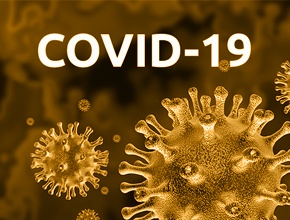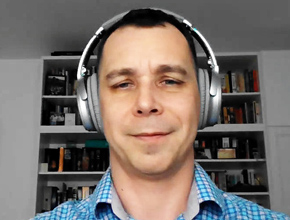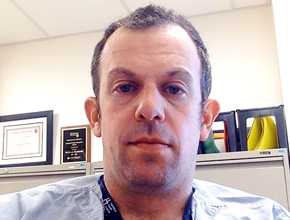Dr Mark Crowther, chair of the Department of Medicine at McMaster University, Leo Pharma Chair in Thromboembolism Research, past president of the Anticoagulation Forum, and fellow of the Royal Society of Canada, joins Dr Roman Jaeschke to provide an expert overview of our current understanding of thrombosis and anticoagulation in patients with COVID-19.
Useful links
YouTube channel of the McMaster University’s Department of Medicine at youtube.com
Anticoagulation Forum webinars at acforum.org
Roman Jaeschke, MD, MSc: Good afternoon. Let me introduce our today’s speaker for McMaster Perspective, Professor Mark Crowther, who’s not only a preeminent researcher of different aspects of thrombosis but also chair of the Department of Medicine at McMaster University and my boss.
Dr Crowther, I listened yesterday to the Medical Grand Round that you ran, which was one of the most enlightening that I’ve heard in a long time. It obviously dealt with coronavirus disease 2019 (COVID-19) and your specialty, thrombosis. Would you care to summarize in a few minutes what we learned in over an hour?
Mark Crowther, MD, MSc: Thanks for the opportunity to speak today. I’ll be happy to give you a quick summary of the rounds from yesterday.
There were 2 parts to rounds, both of which I think are important. The first is Dr Scott Kaatz, the president of the Anticoagulation Forum, who provided a brief update on COVID-19 from a personal perspective, which I’ll explain in a second. Then Dr Ted Warkentin, who’s a preeminent expert in heparin-induced thrombocytopenia but also has a lot of information on other forms of coagulopathies, did a nice talk on his knowledge to date of the coagulopathy that’s seen in patients with COVID-19.
Scott’s an internist and the president of the Anticoagulation Forum, which cohosted rounds with us at McMaster University. He acquired COVID-19 and was critically ill with it. He was intubated, prone ventilated, and received convalescent plasma as well as many of the other quasi-experimental therapies, which are being utilized for this disease. Very fortunately, despite the very high predicted mortality rate, he has recovered almost completely from it and provided not only a background to the hypercoagulable state but also a personal perspective, which was very valuable. He had a pulmonary embolism as a consequence of his illness, and this illustrates some of the issues about which we’ll talk shortly today. We’re not disclosing any personal health information. Scott’s actually become a bit of a media star as a result of his disease and has appeared on CNN and, interestingly enough, also on ESPN [sports channel], I understand.
Dr Warkentin talked about the coagulopathy and some of the parallels with other forms of coagulopathy. The background to this is that there’ve been numerous reports saying that the rate of venous thromboembolism in critically ill patients with COVID-19 is much higher than expected. A number of studies that have come out of northern Europe have suggested astronomically high rates of venous thromboembolism amongst patients who’ve been in the intensive care unit (ICU). Other studies haven’t reported rates quite that high. There’s a lot of discussion about what the rate truly is. I think everybody would believe that patients with COVID-19 are at least as hypercoagulable as other critically ill patients, and probably more so.
The markers of coagulation activity in these patients tend to be sky-high. The D-dimer level, which is up in all patients who are critically ill in the ICU and is particularly high in patients with disseminated intravascular coagulation (DIC), appears to be remarkably elevated in some patients with COVID-19. We’re doing some work with a group out of New Orleans, where there’s been a vast amount of COVID-19 cases. Some of their figures show D-dimer levels of 32,000 in our units [microg/L], which is astronomically high.
Roman Jaeschke: With the normal range being around up to 500 microg/L, right?
Mark Crowther: Yes, depending on the assay somewhere between 400 and 600 microg/L. In our assays you have to do some special maneuvers to get a value above 4000 microg/L to even read out of the machine, it’s such an unusual result.
One of the things that came up in rounds is the question of where the D-dimer comes from. It is probably because of an endothelial injury that is caused by the virus or the inflammatory reaction to the virus. Diffuse activation of endothelium leading to diffuse activation of coagulation, resulting in this really high D-dimer.
Other markers of coagulopathy develop. Patients sometimes have an elevated prothrombin time or international normalized ratio (INR) and may have elevated partial thromboplastin times (PTTs).
Interestingly enough, Ted talked a lot about fibrinogen levels. Normally in DIC, where coagulation factors are excessively activated, we expect to see a low [fibrinogen]. A lot of patients with COVID-19 who appear to have what otherwise would be a DIC actually have normal or high [fibrinogen]. That’s probably related to the fact that COVID-19 is this profound inflammatory state that we don’t really understand and falls more within the domain of the critical care physician, like you, rather than me as a hematologist.
Suffice it to say that this coagulation activation is quite profound and appears to lead to very high rates of 3 forms of thrombosis. The first is venous thrombosis. The second is microvascular thrombosis, with things like skin necrosis or these very unusual chilblains, like skin reactions that we’re seeing in young people who have the disease, where they would develop these pustular lesions on their feet. And the third is arterial thrombosis. The rate of arterial thrombosis is unknown. It’s probably quite uncommon, but there are case reports of arterial thrombosis in patients with COVID-19—remembering, of course, that the characteristics that put patients at high risk from COVID-19, such as diabetes and cardiovascular disease, also put them at high risk of developing arterial lesions, so it’s hard to know where’s the chicken and where’s the egg in the COVID-19 arterial thrombosis equation.
That having been said, I think your supposition we were chatting about before we started the interview that patients with COVID-19 may require intensified prophylaxis to prevent venous thrombosis is something that people are talking a lot about. I should just go over that very briefly. We’ve known for decades that high-risk patients in the hospital are at high risk of developing deep vein thrombosis and pulmonary embolism. We’ve also known for decades that if you provide effective forms of thromboprophylaxis, you reduce the risk of those events occurring, probably reduce pulmonary embolism, and probably reduce death.
The standard prophylaxis in most hospitals outside of the United States is low-molecular-weight heparin (LMWH) administered usually once daily. The standard prophylaxis inside the United States in many places is probably still unfractionated heparin or twice-daily LMWH. The dose of LMWH is pretty standardized everywhere. It is probably the equivalent of enoxaparin 40 mg or dalteparin 5000 IU once a day.
The hypothesis that is evolving is that patients with COVID-19 are at particularly high risk of venous thrombosis and maybe they should have dose intensification. How we do that is going to be subject to additional study. In many centers this has come down to very simply doubling the dose, so enoxaparin 40 mg twice a day or dalteparin or its equivalent 5000 IU subcutaneously twice daily in those critically ill patients who presumably are at very high risk of venous thrombosis.
Roman Jaeschke: This would be quite useful. On the basis of similar information but not as profound knowledge I reached the same conclusion. As of next week, when I start to look after these patients, I will at least double the dose.
I’m also thinking that there’s unexplained hypoxia or hypoxia out of proportion to the observed x-ray or computed tomography (CT) changes. Rather than looking for pulmonary embolism, I may actually fully anticoagulate these patients. Any comments on that?
Mark Crowther: This is kind of an interesting back-to-the-future thing. For 20 years we’ve been telling people that you should never make an empiric diagnosis of either deep vein thrombosis or pulmonary embolism, and now we’re faced with this unusual circumstance where a lot of these patients are either too ill to move to do testing or we don’t want to move them to do testing because then we have to decontaminate the CT scanner, ultrasound machine, or the health-care professionals that have to deal with the patients when they’re rolling through the hospital. So we’ve reentered the era of empiric diagnosis.
I think if you had a patient in whom you as a critical care physician could not explain the degree of hypoxia or of resting tachycardia or if they had that unexplained unilateral leg swelling, you knew they had COVID-19, and you know there’s an enhanced risk of venous thromboembolism, it’s quite reasonable to empirically anticoagulate those people. As soon as they’re sufficiently stable and hopefully noninfectious, I would do some imaging to try to confirm that the diagnosis was accurate, but that certainly is less urgent.
Roman Jaeschke: We’ll obviously need to remember about the risks of bleeding, so that may be another thing influencing the threshold, right?
Mark Crowther: Absolutely. I was going to say that next. There’s 2 special cases about anticoagulation in patients with COVID-19. The first is that just because you have COVID-19 and you’re maybe “hypercoagulable” doesn’t mean that you don’t have a risk of bleeding. In therapeutic anticoagulation in critically ill patients it’s always a high risk. There’re already cases of pulmonary hemorrhage in COVID-19 patients who receive empiric therapeutic-dose anticoagulation.
The second thing that was raised at rounds yesterday, which is also really important, is that these patients have this profound inflammatory state and they’re heparin resistant. A very common observation is that intravenous unfractionated heparin, which may be the preferred agent in some of these patients, requires really high doses to achieve therapeutic PTTs or you may not be able to achieve a therapeutic PTT. There has been evidence now for some time that the anti–factor Xa activity level, which is available in most hospitals but not as urgently as the PTT, may actually be a better way of monitoring unfractionated heparin in patients who have this inflammatory state. The second part is that we normally say that LMWHs are immune to that inflammatory state, but it might be the case that the state is so profound here that LMWHs may also be somewhat inhibited. It’s important to consider even checking levels of LMWH, which we normally wouldn’t do.
Roman Jaeschke: I really appreciate this clinical comment. Now an organizational question. As you know, we’ve had to cancel the 6th McMaster International Review Course in Internal Medicine (MIRCIM) in Kraków, Poland, and the 12th McMaster University Review Course in Internal Medicine in Hamilton, run by Prof Akbar Panju. This grand round yesterday was extremely valuable. Could we somehow make those available, at least for people who participated or who will express interest in participating in the McMaster internal medicine courses?
Mark Crowther: All of the grand rounds that we’re recording right now are available on the Department of Medicine’s YouTube channel. The one from yesterday is not hosted there because the conference was hosted by the Anticoagulation Forum, but you can also find that by googling “Anticoagulation Forum webinars,” and it’s there as of this morning [May 15]. So all of our previous content is available online, and the rounds from yesterday are on the Anticoagulation Forum webinar website.
Roman Jaeschke: They were so good that I’ll try to use them for marketing of our courses.
Thank you so much for this summary. I think this round’s changed the behavior of clinicians. Obviously the answers will be in randomized controlled trials (RCTs), which should be available in a few months. For now, I really appreciate your time.
Mark Crowther: Thanks, Roman. It’s a great honor to do a presentation for you. And yes, they were really good rounds and we’re really proud of the great experts at McMaster University and their relationships with people around the world.
Roman Jaeschke: And that’s called marketing as well. Thank you very much. Take care.
 English
English
 Español
Español
 українська
українська











